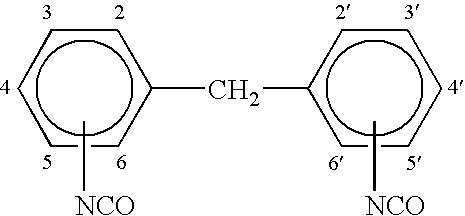Water curable polyurethane compositions and uses thereof
- Summary
- Abstract
- Description
- Claims
- Application Information
AI Technical Summary
Benefits of technology
Problems solved by technology
Method used
Image
Examples
example i
Preparation of Sample 1
[0092] A prepolymer was prepared by mixing 43 parts by weight by weight of a 2000 molecular weight (all molecular weights refer to weight average molecular weight unless otherwise noted) polypropylene glycol diol (Pluracol P 2010) and 5 parts by weight by weight of a 4800 molecular weight polypropylene glycol triol (Pluracol P 1421) with 20 parts by weight by weight of methylene diphenyl diisocyanate (Lupemate MI). The methylene diphenyl diisocyanate was a commercial blend of about 45 to 51% by weight 4,4′-MDI and about 49 to 55% by weight 2,4′-MDI. In addition, the ingredients also included 0.2 parts by weight by weight of DBPC-BHT antioxidant and 6 parts by weight by weight of Diisononyl phthalate (DINP) as plasticizer / solvent. The ingredients were heated at about 230° F. for about 2 hours in a closed reactor vessel.
[0093] The product was an NCO functional prepolymer with an average NCO content of 6.5%. The prepolymer viscosity after cooking was 2900 cps a...
example 2
Preparation of Samples 2-10
[0096] Samples 2 through 10 were prepared and tested in accordance with the procedure of Example 1, except that the formulations shown in Tables 2-1 and 2-2 were used. Additionally, the catalyst dioctyltin mercaptide was used in Samples 6-10 in place of dibutyltin dilaurate. The composition and data for Sample 1 is included for comparison purposes.
TABLE 2-1IngredientsSamplePrepolymer (1)12345678910Mondur ML mix of 4,4′ and 2,4′ MDI202426.5Lupernate MI mix of 4,4′ and 2,4′ MDI201626.52024Lupernate MM 103 4,4′-MDI23Rubinate 9433 mix of 4,4′ and 2,4′ MDI21Pluracol P 2010 diol434340424740.243343440.2Pluracol P 1421 triol555555.35775.3BHT antioxidant0.20.20.20.20.20.20.20.20.20.2Diisononyl phthalate6666666Propylene Carbonate565% NCO - checked6.87.037.26.74.959.356.899.169.54Viscosity CPS @ 80° F.2900217046603940376015102000215017001530
[0097]
TABLE 2-2SampleIngredients12345678910Slurry (2)Diisononyl phthalate16161616161616Propylene Carbonate101610White Paste22...
example 3
[0098] Samples 11-21 were prepared and tested in accordance with the procedure of Example 1, except that the formulations in Tables 3-1 and 3-2 were used.
[0099] In the tables of this example, the following terminology was used: [0100] Y-Yes, [0101] N-No, [0102] G-Glossy, [0103] F-Flat [0104] W-With Catalyst [0105] W / o-Without Catalyst→Same procedure as With Catalyst except 0.02 gram of
[0106] Diotyltin Mercaptide is excluded. Procedure for checking work life for samples 11-21: @80° F. Take 100 grams of material and add 0.02 grams of dioctyltin mercaptide. To this mixture, add 23 grams of tap water. Mix for about 1 to 2 minutes and then check for non-flow characteristics.
TABLE 3-1Products1112131415161718192021Prepolymer(1)Lupernate MI2020202020202020202020Pluracol P 20104343434343434343434343Pluracol P 142155555555555BHT0.20.20.20.20.20.20.20.20.20.20.2% NCO - checked7.27.27.27.27.27.27.27.27.27.27.2Viscosity CPS @ 80° F.54005400540054005400540054005400540054005400Slurry (2)Diison...
PUM
| Property | Measurement | Unit |
|---|---|---|
| Fraction | aaaaa | aaaaa |
| Percent by mass | aaaaa | aaaaa |
| Percent by mass | aaaaa | aaaaa |
Abstract
Description
Claims
Application Information
 Login to View More
Login to View More - R&D
- Intellectual Property
- Life Sciences
- Materials
- Tech Scout
- Unparalleled Data Quality
- Higher Quality Content
- 60% Fewer Hallucinations
Browse by: Latest US Patents, China's latest patents, Technical Efficacy Thesaurus, Application Domain, Technology Topic, Popular Technical Reports.
© 2025 PatSnap. All rights reserved.Legal|Privacy policy|Modern Slavery Act Transparency Statement|Sitemap|About US| Contact US: help@patsnap.com

